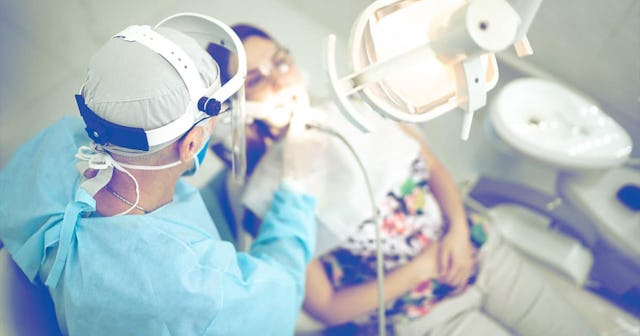Dentists Weigh In On The Safety Of Those Checkups That You've Likely Delayed

As I watch my son eat his thousandth gummy bear since the pandemic canceled schools and camps and life as we know it, I can’t help but to think of that dentist appointment he was supposed to have in April. The one that came and went while my children were engaged in questionable brushing as I navigated working from home and crisis schooling. The one that came and went back in April when dental offices were closed, when the idea of being within inches of a face that didn’t live in my house was unthinkable.
Which means, he’s probably needs a dentist visit, and certainly my kids are overdue for their bi-annual dentist visit.
Dental offices are open now, but to be honest, the idea of being within inches of a stranger’s face is still unthinkable. In the earliest days of the pandemic, the CDC recommended that all dental offices shut down, except for urgent or emergency situations. As the pandemic rages on, the CDC has revised that recommendation and provided specific guidance for dental care during the pandemic.
But, is it safe? Is it safe to sit within inches of a stranger, without a mask on? To open your mouth and breathe? Is it safe for my kids, for the dentist, for the dental hygienist…for their families and the other patients and the community at large?
The answer is complicated—because isn’t every question and answer duo that pertains to COVID-19 complicated?
The truth is the absolute safest way to avoid contracting COVID-19, to avoid spreading it to the dentist and the hygienist and anyone living in their homes, is to stay home, to only go out for essentials while wearing a mask and social distancing. It’s impossible to wear a mask at the dentist and there’s no way to social distance from someone who needs to stare into your mouth and inspect each one of your teeth.
Not to mention, there’s a real risk to dental health care workers. According to the CDC “the practice of dentistry involves the use of rotary dental and surgical instruments, such as handpieces or ultrasonic scalers and air-water syringes. These instruments create a visible spray that can contain particle droplets of water, saliva, blood, microorganisms, and other debris.” Surgical masks offer some protection, but not complete protection against inhalation of airborne agents, and we know an extensive amount of transmission happens via asymptomatic or presymptomatic individuals.
All of that might lead me to the answer that I should cancel my children’s bi-annual dentist appointment: it’s not an essential, and there’s no way to follow safety protocols.
svetikd/Getty
And yet, the pandemic is definitely stretching into the fall, and as we look ahead and see no true end date, chances are it’ll climb into the winter months, too. And while so many things are canceled, cavities and gum diseases have not gotten the memo.
The New York Times spoke to two dentists who closed their offices for all but urgent and emergent visits during the height of the pandemic in New York City. They worried about the patient with a simply cavity in January, who was unable or unwilling to get the cavity filled, and would now need an expensive and invasive root canal or even a procedure to remove the tooth and install an implant.
“Every stage of dental care has a level of urgency. Problems that were put off can flare up. If patients are in pain, it’s already too late,” Dr. Edward Lee told the Times.
Scary Mommy spoke with a local dentist who confirmed that it’s safe for children to go to the dentist. Her office has taken steps above and beyond what is recommended to ensure that patients and staff are safe. Appointments are spread out, ventilation systems were installed, and new forms of PPE were procured for staff. She echoed the sentiment of the dentists interviewed by the New York Times as it relates to children’s bi-annual visits. She says, “Kids generally have poor brushing technique so if they are due for their six month visits, they need to have their teeth properly cleaned. Also, they need their fluoride treatments to keep their soft enamel strong to fight tooth decay.”
The answer may come down to your own personal level of comfort, the number of cases in your area, and the level of transmission in your region. Someone living in an area where the virus is surging may make a different choice than someone living in an area where cases are declining, or at least plateauing.
If based on all of that, you do decide to take your children to the dentist, be sure that the dental office you are visiting is following all CDC guidelines and mitigating the risk as much as possible. Dental offices should be disinfecting more often, wearing protective gear, spacing out appointments, checking temperatures and inquiring about other symptoms upon entrance into the office, asking clients not to arrive early to avoid crowds in waiting rooms, and removing any common items patients may touch in the waiting room, such as toys or magazines.
As the pandemic continues to rage, the question of “is it safe?” will be one we all can expect to confront again and again. As the virus surges and recedes, as lockdowns lift and resume, the way we answer “is it safe” will change. And ultimately, the takeaway, for my family, might be to stop eating so many gummy bears…or at least raise the level of teeth brushing from questionable to exemplary.
This article was originally published on